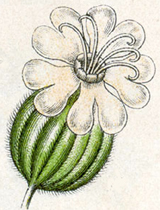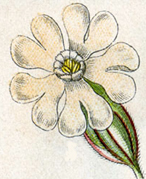 Silene alba
Silene albaGrave Flower
Also known as White Camption, and sometimes called Mother-Die, Grave Flower is unlucky to pick in some parts of England. It was associated with snakes in Nebraskan folklore and oddly enough, in Wales, where it was believed that anyone who picked it would be attacked by snakes. In Welsh folklore, picking it could also cause thunder, giving rise to another of its common names, thunder flower. Prohibition of picking a plant usually means the plant is connected to the Fae, which is indeed the case with grave flower. Snakes, the Fae, and graves are all associated with the Underworld (Fae live under the hill, snakes = dragons, a chthonic creature, graves go without saying). Perhaps the fact that the flower opens and exudes scent at night has something to do with this, but we were not able to find further information. Some say this flower is dedicated to Hera and was woven into garlands for her in ancient Greece; we couldn't find anything to back that up, but this plant has gone through a LOT of name changes in the past couple hundred years. In an odd conmnection between love and death that goes back to ancient Greece, grave flower was used in British folk magic to attract men. Consider this Saturn herb for working with the dead, the Fae, raising storms, and love magic. Because of its connection to graveyards, it seems there is a lot more to this plant magically than meets the eye.
 Individual grave
flower plants have gender (all flowers on
the plant will be either female or male; females have a fatter "bladder").
This European native has been naturalized in North America,
much like other Europeans. The fragrant flowers open in evening
and stay open until the following mid-morning. They are pollinated
by sphinx moths, which also enjoy jimsonweed, toloache, and woodland
tobacco. Simmering the root makes a soapy water for textiles. This
soapiness also indicates a mild toxicity; the root of this plant
was made into a purgative by Native people. However, cooking destroys
the saponins, and the leaves of grave flower are included in mixed
greens that are boiled, strained, and dressed with olive oil in
Dalmatia (part of Croatia). It is also part of an ancient herb soup
recipe in Italy called "ministrella," which is composed
of 27 leafy greens. Grave flower was in the past called bachelor's buttons
because of the shabby cloth buttons bachelors might wear, the tattered
edges of which resembled the edges of this flower's petals.
Grave flower is also known as white campion, death flower (Germany),
flower of the dead, grave plant, white bachelor's
buttons, our lady's candles, thunder flower, cow rattle, white robin,
white cockle, white cuckoo flower, white bottle, evening lychnis,
and bladder campion (though not to be confused with Silene vulgaris).
Individual grave
flower plants have gender (all flowers on
the plant will be either female or male; females have a fatter "bladder").
This European native has been naturalized in North America,
much like other Europeans. The fragrant flowers open in evening
and stay open until the following mid-morning. They are pollinated
by sphinx moths, which also enjoy jimsonweed, toloache, and woodland
tobacco. Simmering the root makes a soapy water for textiles. This
soapiness also indicates a mild toxicity; the root of this plant
was made into a purgative by Native people. However, cooking destroys
the saponins, and the leaves of grave flower are included in mixed
greens that are boiled, strained, and dressed with olive oil in
Dalmatia (part of Croatia). It is also part of an ancient herb soup
recipe in Italy called "ministrella," which is composed
of 27 leafy greens. Grave flower was in the past called bachelor's buttons
because of the shabby cloth buttons bachelors might wear, the tattered
edges of which resembled the edges of this flower's petals.
Grave flower is also known as white campion, death flower (Germany),
flower of the dead, grave plant, white bachelor's
buttons, our lady's candles, thunder flower, cow rattle, white robin,
white cockle, white cuckoo flower, white bottle, evening lychnis,
and bladder campion (though not to be confused with Silene vulgaris).
How to Grow Grave Flower
 Barely cover to germinate in 2-3 weeks at
68-80F/21-27C. This plant gets 1.5-3.5ft/30-100cm
tall. It likes rich soil (compost heaps), full sun, and chalky soil--you
can see why it is fond of growing in cemeteries, where it has these
things. It also enjoys growing
along footpaths, roadsides, banks, edges of woodlands and prefers
dryish soil to boggy. It does not do well with acidic, peaty soil. It
flowers May-September and can be annual, biennial, or a short-lived perennial.
It reproduces
mainly through seeds, which can live underground
for 70 years, although 3 years is more common. One plant can
make 25,000 seeds, but they tend to fall out of the dried seedpods
in winter, where they provide food for overwintering small birds like sparrows
and finches.
General growing
info
Barely cover to germinate in 2-3 weeks at
68-80F/21-27C. This plant gets 1.5-3.5ft/30-100cm
tall. It likes rich soil (compost heaps), full sun, and chalky soil--you
can see why it is fond of growing in cemeteries, where it has these
things. It also enjoys growing
along footpaths, roadsides, banks, edges of woodlands and prefers
dryish soil to boggy. It does not do well with acidic, peaty soil. It
flowers May-September and can be annual, biennial, or a short-lived perennial.
It reproduces
mainly through seeds, which can live underground
for 70 years, although 3 years is more common. One plant can
make 25,000 seeds, but they tend to fall out of the dried seedpods
in winter, where they provide food for overwintering small birds like sparrows
and finches.
General growing
info
Silene alba
Grave flower
100
seeds $3.75
This seed cannot be shipped to Wisconsin.
Uses in Witchcraft & Magic:
Working with the
Dead
Fae herb
Raising storms
Love magic
Saturn herb
© 2000-2024 Alchemy Works;
No reproduction without permission